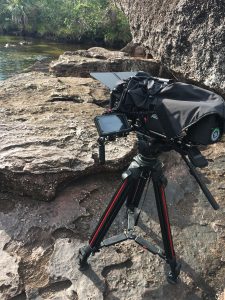Cartoni Tripods Navigate Tough Terrain, Rough Conditions for Filmmakers
Story Highlights
Even amid the most primitive conditions, the demand for quality video was as high as ever for cinematographer Michael Moghaddam and his crew as they embarked on a video mission to study the effects of deforestation deep in the Amazon Rain Forest in Columbia.
 Moghaddam was part of a small crew tasked with producing a documentary on the study of deforestation and its impact on the environment.
Moghaddam was part of a small crew tasked with producing a documentary on the study of deforestation and its impact on the environment.
In partnership with Google, the film documented scientists’ use of artificial intelligence and technology to study the effects of deforestation on wildlife and the ecosystem. According to a recent UN report, as many as one-million species could be extinct within a decade if the tide of deforestation is not stemmed.
Despite the tough conditions, the necessity for high-quality gear was paramount. Even without the luxury of a reliable generator, Moghaddam still brought the most sophisticated gear available.
The crew filmed on two ARRI Alexa Mini cameras, the same brand of power-hungry digital cinema cameras used by many Oscar-nominated filmmakers. To support the cameras, Moghaddam chose the Cartoni Focus 12 SDS tripod, which was lightweight and robust enough to tote through the jungle, yet efficient enough to set up quickly and get smooth, steady once-in-a-lifetime shots.
The Focus 12 fluid head features a continuously variable counterbalance system and a 100mm bowl base, which provides enough support for larger cameras while supporting a payload of 26 pounds.
“We needed to be as light and self-contained as possible,” Moghaddam said. “But at the same time, if the tripod is not solid, there are going to be issues. In fact, our “B” camera operator ended up bringing his tripod, which was a competitor to the Cartoni. We would joke around about how bad his set up was compared to mine. The sticks were okay but the competitor’s head was total garbage, even though it said it could support the same payload as the Cartoni. We found that whenever we went with one set-up, we would go with the Cartoni.”
Moghaddam and his team interviewed scientists who were using camera traps to track wildlife in the forest. The scientists were able to upload their footage to Wildlife Insights, a new Google cloud-based platform that uses artificial intelligence and other technology to identify animals in images captured from camera traps placed in the wild.
Artificial intelligence helps reduce the laborious manual work of sifting through volumes of camera trap images and helps biologists devote their time to actually working to study and protect wildlife.
“It was definitely pretty ambitious,” Moghaddam said of the project. “Where we were staying in the jungle was an old farmhouse that you know didn’t have electricity. We had a generator that we got to run for two hours a day to power our batteries. It was all open air. We slept under bug nets. There was an outhouse and well water. We were definitely really in it.”
A peace treaty that was forged between the government and a violent, leftwing rebel group that had been protecting the forest created a free-for-all for individuals and groups to go in and slash and burn swaths of the jungles.
“If you can clear a part of the land and you can show to the government, then it’s yours and the government will give it to you,” Moghaddam said.
The scientists in the region who were studying the biosystem gave the film crew free rein and were available for candid interviews.
Moghaddam cited one scientist, whose research focused on tracking jaguars, considered an apex predator, which is a predator at the top of the food chain.
The scientist’s research showed that if you track the Apex predator, it will tell you about everything else about the environment. That’s because if there is not enough food for the main predators and they leave the environment that means the whole environment is out of whack, Moghaddam said.
Through his video, Moghaddam tried to showcase the biodiversity of the region and the harmful effects of deforestation on the entire region.
“The director tried to approach it more journalistically but we definitely tried to, you know, make it more cinematic I guess and more than just a typical news piece,” Moghaddam said.
